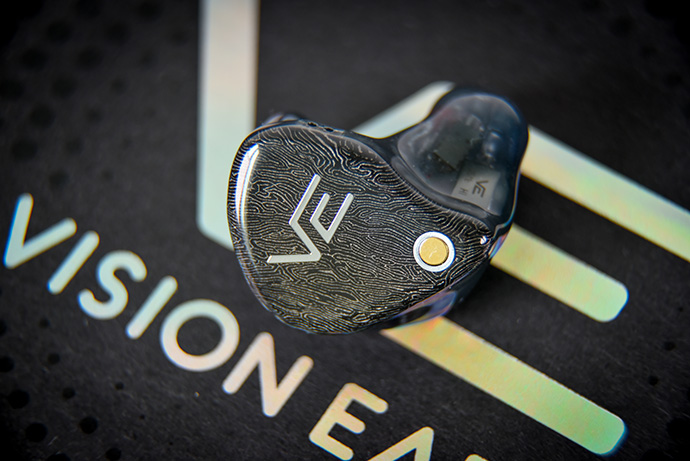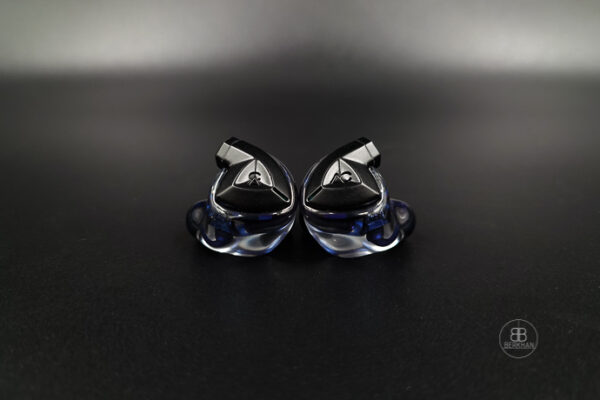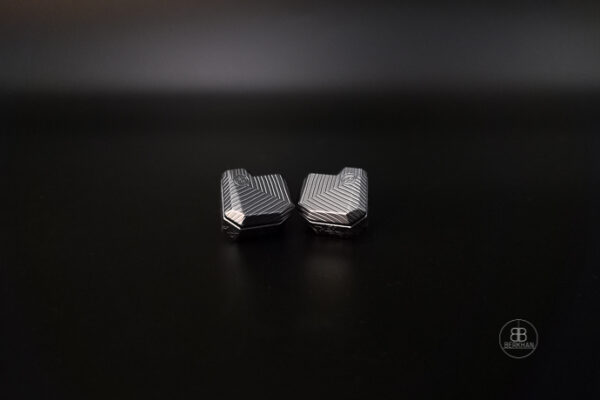If Google brought you here directly, jump to page one!
My unit features a translucent body and their Copper Carbon Steel faceplate with silver logos on both sides. It looks incredibly good! My pictures don’t do them justice in my opinion. This design is also featured on Vision Ears’ website though.
Vision Ears produces their custom IEMs with acrylic filled shells, which adds stability to the entire housing and makes the IEMs more robust. I don’t recommend giving them a beating, but they can take more punches than other, hollow, shells. This is a big plus in my book, as it means that the shells of my XCON won’t crack soon.
VE definitely doesn’t disappoint when it comes to build, and I am very happy to see their high standards continue.

Sound
The sound of the XCON depends on the currently used setting, as the IEM possesses two signatures. The X1 signature is described on Vision Ears’ website as the more energetic and fuller one, while the X2 setting is supposed to sound more neutral and analytical.
Since the XCON has made its way into my hands, I have used it extensively on a daily basis in transit and especially at work. It was mostly paired with my Astell&Kern SP3000M, my Lotoo PAW Gold Touch II and my PAW Gold Touch. I haven’t tried desktop gear like the Hugo TT2 with it.
The following description is based on the X1 setting – magnet in. A brief description of the X2 sound will follow at the end of this section.
Vision Ears opted for a generally darker and fuller sound signature with the XCON. It has an organic and natural, yet fattened up sound. XCON has an emphasis on the lower midrange, which gives male singers a denser and thicker vocal appearance. Bass is typical for a balanced armature implementation with limited sub-bass reach, but good mid- and upper-bass body and volume.
Female vocals sometimes have a harder time shining through the darker tune of the monitor, but sport excellent levels of emotions and richness. Treble is more laid-back and shows an earlier roll-off, which gives the XCON a softer and more approachable tuning.
Let’s dive deeper.
The XCON has a full and big bass tuning, which has a clear focus on mid and upper bass. It has good speed and a tightly controlled low-end. When it comes to sub-bass extension, the XCON is rather limited due to the balanced armature driver. People craving an impactful and thunderous low-end might not find the XCON to be their cup of tea.
It has good rumble for a BA, but misses out on physicality in my opinion. This was particularly audible with tracks containing a more prominent percussion segment, like Eagles MTV live version of Hotel California. Here the drums just didn’t contain the level of physical density I am used to.
However, the XCON possesses wonderful punch when needed. Tracks like Uche Yara’s As I Left the Room or Feel it Still by Portugal. The Man are good examples here, where the XCON shows its abilities. The resolution and texture of the XCON are both good, with lower range string instruments being particularly nice to me. The low-end body has a big, yet a little lighter appearance.
One of the XCON’s key-features is the lower midrange body size and weight. It’s beautifully done and transports excellent weight. Deeper male vocals and lower pitched instruments both sound wonderful to me. One of my favorite test tracks here is Muffin Man by Frank Zappa, his voice here comes across with splendid body and weight, giving this track what it needs to fully anchor it.

The midrange overall has an organic and natural tuning, although it could benefit from slightly more upper midrange clarity to give female vocals a bit more energy and presence. Sometimes, when the tracks are busier in the lower frequency ranges, female singers have a harder time shining through. An example here would be Björk’s voice in Atom Dance.
Instruments generally have a natural sound with a slight dip into the darkness. Vocals are emotional and weighty, at times I wished for more air in and around them, just to get them more up on their feet so to speak. The XCON’s mids ask for acoustic music in my opinion, as it shows its full strength there the best.
I can wholeheartedly recommend acoustic pieces like Angus & Julia Stone’s Draw Your Sword or Brandt Brauer Frick’s Mi Corazon. Both tracks are prime examples where the XCON shows its ability to render lifelike and natural instruments.
In terms of technicalities, the XCON is a good performer, albeit being a little limited due to the darker signature of the X1 setting. It has good resolution across the board and delivers nice instrumental separation. However, if you are looking for a detail monster with crazy staging, you might not find the XCON appealing.
The VE has a stage that stretches more into depth than width or height. It’s a longer room with narrower dimensions. With the XCON you will be a more intimate presentation, where vocals can be close to you.
The XCON delivers a smoother texture and a dark background. Instruments are well lit, but could have better contouring and higher contrast to the background. The XCON has a seamlessly coherent tuning, where every driver works in unison with each other. It has good layering, but could do with a little more air here, which would give them a bit better positioning in my opinion.
The treble has an inoffensive tuning and comes across with decent clarity. However, in X1 setting the highs are not the star of the show in my opinion. Cymbal crashes, violins and other high pitched instruments and tones have a smoother sound, that’s tuned in a more laid-back way. This gives them a forgiving nature where you don’t have to worry about piercing highs with sibilance.
Tracks that show the quality and tuning of the XCON’s treble are Sunshine Underground by the Chemical Brothers or Kishi Bashi’s I am the Antichrist to You. Here the instruments are a bit tamed, but still possess good clarity and won’t ever pierce your ears. Although the high hat hits in Sunshine Underground do have a harder time coming through the darker tonality of the XCON.
Now that we know how the XCON sound with the magnet installed, we can quickly go over the changes of the sound when using the X2 signature.
When using the X2 setting, the sound generally becomes more neutral, where bass and midrange presence is lowered, giving the monitor’s upper mids and treble more focus. I wouldn’t call this setting studio neutral, but more of a natural neutral signature. Without the magnet, you will get more air around each instrument, a wider staging and better separation and layering. The darker sound now is swapped out for a more in-line tuning, where there is no clear front-runner frequency. You will still have good body and weight, but also a less physical lower midrange especially.
The sound will change from dark energetic to neutral and almost analytical, although its body size and appearance are not what I’d attribute to an analytical tuning.
The part on sound continues on the next page. Find out more about the XCON on page 3!









